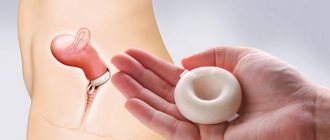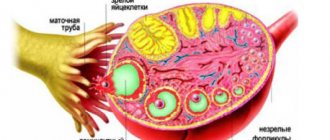Vaginal dryness, burning, pain in the urethra, labia minora - this is real suffering, this is martyrdom! Intensifies with every touch, with every urination. The severity of complaints ranges from mild tingling to long-term non-healing cracks at the vaginal opening. These complaints can deprive you of sleep and cause very severe discomfort. What kind of “family” life can we talk about if “there” everything is on fire? Unfortunately, it won't get better with age. The only way out is hydration and “no touching”….
Vaginal dryness during menopause is directly related to a decrease in estrogen. Scientific names: vulvovaginal atrophy or genital menopause syndrome. The latter name covers a wider range of age-related changes in the external genitalia that occur in mature women.
At the very beginning of menopause, only 4% of women experience discomfort, but with age, every second woman suffers from dryness and atrophy of the genitals.
Genitourinary syndrome of menopause (GSM) is a new term for vulvovaginal atrophy (VVA). Symptoms of estrogen deficiency in the urinary tract affect more than 50% of women, which negatively affects quality of life, social activity and family relationships.
GSM is a chronic and progressive syndrome, women are reluctant to complain about this problem, and doctors usually cannot recommend anything other than hormonal pills or creams.
GSM includes dryness of the vagina, vulva, thinning of the pelvic floor tissues, urinary tract, sexual dysfunction, pain to touch and lack of lubrication. These complaints are caused by hypoestrogenism during menopause and postmenopause. Changes in the genitourinary system primarily occur in response to declining estrogen levels and aging. Many patients are reluctant to report these symptoms for many reasons.
How does genital syndrome develop?
Estrogen receptors are present throughout the genitourinary system, in the vestibule of the vulva, urethra and bladder, and on autonomic and sensory neurons in the vagina and vulva. The highest concentration of estrogen receptors is found in the vagina, with only alpha estrogen receptors active in postmenopause. Testosterone receptors are concentrated mainly in the deeper layers of the vagina, while progesterone receptors are also found in the vulvovaginal epithelial junction.
Loss of estrogen causes anatomical and functional changes leading to physical symptoms in all genitourinary tissues. Tissues lose collagen and elastin; smooth muscle function changes; the number of blood vessels decreases and connective tissue increases. As a result, thinning of the epithelium occurs; decreased blood flow; and elasticity decreases. Vaginal dryness is also associated with changes in the epithelium. During menopause, intermediate and superficial cells predominate and there are few parabasal cells, whereas after menopause the amount of parabasal epithelium increases, and sometimes there is an increase in intermediate and loss of surface epithelium.
“Bouquet” of anatomical and functional changes in the external genitalia during menopause
- Loss of labia density
- Contraction of the clitoral hood
- Narrowing and stenosis of the entrance
- Loss of membranous remains of the hymen, decreased tissue elasticity
- Vaginal contraction and narrowing
- Prolapse of the vaginal walls
- Weakness of the pelvic floor
- Vaginal epithelium is dry and thin with petechiae
- Loss of superficial cells and increase in parabasal cells
- Loss of vaginal scars
- Inflamed vaginal tissue
- Vaginal secretions become alkaline. Local microflora changes - with loss of lactobacilli (vaginal pH> 4.5)
- Persistent or recurring thin discharge with an odor
- Diseases of the urethra and prolapse of the urethral sinus with thinning of the urethral epithelium
- Sexual sensations change either towards increased painful sensitivity, or a decrease in sensitivity occurs.
- Loss of clitoral sensitivity
Concomitance of pathological conditions
Changes in hormonal levels in the female body, associated with a decrease in the amount of estrogen, can contribute to the development of the following accompanying pathological changes, the development of which can also provoke the formation of itching during menopause, namely this:
- The formation of diabetes mellitus , accompanied by elevated glucose levels, contributing to the development of vascular disorders. This, in turn, becomes the cause of pathological disruption of the blood supply to organs and tissues. There is also an increase in glucose content in the urine. This has an irritating effect on the mucous surfaces in the vaginal area when urinating.
- inflammatory pathologies in the genitourinary organs. Itching and burning in the intimate area begin to appear due to contact of the mucous membranes of the vaginal surface with the breakdown products of urea, which are part of the biofluid that is excreted from the urethra. And with an increased urge to urinate, the urine released begins to irritate the surface of the vulva for a long time.
- The development of dermatitis or an allergic reaction to the use of certain types of soap for hygiene procedures, towels or underwear.
- The development of candidiasis or thrush, accompanied by the development of the candida fungus, which contributes to the formation of cheesy discharge and the appearance of a feeling of itching in the vagina during menopause, which usually intensifies at night.
- The development of vulvovaginitis , characterized as natural processes leading to the formation of itching and dryness in the vaginal area. This will cause a desire to itch for a long period of time if timely treatment is not started to eliminate the itching. During the development of this pathology, microcracks may appear on mucous surfaces. Infectious microorganisms can easily get into them and lead to aggravation of this pathology. Moreover, the itching sensation will not stop, and the labia will begin to swell and turn red, becoming covered with small ulcerative lesions, causing even more discomfort to the woman.
Frequency of complaints
Many studies have examined the frequency, type of symptoms, and their impact on health and quality of life. In a study of women's average lives in Melbourne, vaginal dryness increased with age - from 4% in early menopause to 25% within a year of menopause and 47% three years after menopause.
Dryness and burning vary from mild to moderate to debilitating. Other studies have shown that 50% of respondents aged 50-60 years report genital discomfort. Complaints of dryness increase by up to 72% in women over the age of 70, but only 4% attribute these complaints to the loss of estrogen during menopause.
The most concerning symptoms were vaginal dryness and dyspareunia (pain during intercourse);
- Some patients experience a burning sensation even without sexual intercourse, during everyday life.
- Symptoms may be multiple or completely absent.
In the Women's Health Initiative study, 60% of participants had physical signs of genitourinary atrophy, but only 10% said they had vaginal dryness and burning. Estimates show that only 7% of women consult a doctor. Many ladies are unaware of the available treatments.
Symptoms following surgical menopause, breast cancer treatment, and premature menopause are often more severe and debilitating.
Social attitudes towards female sexuality in old age are essentially negative, and sexual problems are often considered part of normal aging, resulting in many women not seeking medical attention.
There is a discrepancy between the number of women who experience bothersome symptoms and those who are treated. First, patients are shy and embarrassed to discuss their symptoms, especially if:
- the doctor is young and male;
- the patient had previous negative experiences with the doctor;
- the patient views these symptoms as a natural part of aging that she must “get over.”
- Women often wait for their doctor to ask questions.
Secondly, the doctor may also be embarrassed and reluctant to discuss issues of sexual function. Health care providers may also not be aware of available treatments or recommended dosages.
Phytoestrogens and hormone therapy
During menopause, a woman's hormonal background changes. It is for this reason that she may feel a burning sensation during menopause, since she lacks natural hormones. Natural sources of phytoestrogens will help solve the problem. They are found in legumes, soybeans, and red clover. Women are recommended to use drugs such as Remens, Estrovel, Klimadinon. These drugs contain special substances that compensate for the lack of natural estrogens, but, unlike hormonal therapy, have virtually no side effects. They should be taken in courses to maintain the hormonal balance of female microflora.
How to reduce complaints
There is no cure for GSM and the goal of treatment is to alleviate vaginal dryness and pain. If the pain and burning sensation are very strong, you can apply lidocaine cream once.
Attention! Lidocaine cream can also increase local irritation; it can only be used as an emergency treatment to induce local anesthesia!
Definitely useful:
- Lifestyle changes;
- diet and exercise;
- drinking water to reduce urine concentration;
- exclusion of spicy dishes;
- stopping smoking and drinking alcohol.
REPORT
RESULTS Ñ, ÑÑо Ñама по Ñебе ÑÑа Ð ¿Ñоблема никогда не пÑÐ¾Ð¹Ð´ÐµÑ Ð´Ð¾ ÑÐµÑ Ð¿Ð¾Ñ, п ROOM ROOM ROOM ROOM ¿ÑиÑина. ROOM RESULTS ÑоÐ" Ñко на инÑимном здоÑовÑе дамÑ. RESULTS µÑÑÑ ÑиÑк ÑазвиÑÐ¸Ñ ÑеÑдеÑно-ÑоÑÑдиÑÑÑÑ Ð·Ð°Ð±Ð¾Ð»ÐµÐ² а ROOM Ñдов. OPTIONS µÐ¹ к квалиÑиÑиÑÐ¾Ð²Ð°Ð½Ð½Ð¾Ð¼Ñ ÑпеÑиалиÑÑÑ Ð¸ п RESULTS ¹ ²ÑÑеназвР°Ð½Ð½ÑÑ Ð½ÐµÐ´Ñгов.
Analyzes
- Studies are not carried out regularly, but depending on specific results and possible differential diagnoses.
- Investigation for any postmenopausal vaginal bleeding is mandatory.
- A smear is done if there is vaginal discharge or vulvitis to rule out infection.
- If there are suspicious visible areas of epithelium, or there is no improvement with treatment, a vulvar biopsy may be required.
- Urine tests may be needed if symptoms are related to the bladder and urethra.
How to get rid of itching and burning at home
One of the main principles of getting rid of dryness in the intimate area during menopause is maintaining hygiene. At home, you can relieve symptoms with baths of herbal decoctions, which have an anti-inflammatory and soothing effect. Decoctions of the following medicinal herbs are suitable for daily hygiene:
- Sage,
- Pharmaceutical camomile,
- succession,
- Yarrow,
- Celandine.
However, even when using these decoctions, itching in the intimate area during menopause requires specialized treatment. If unpleasant symptoms occur, you should not delay your visit to the gynecologist. Improvement in well-being with well-chosen therapy will not take much time, but if treatment is not timely, complications may develop, which will then be much more difficult to cure.
Important! The use of traditional recipes can only alleviate unpleasant symptoms, but you can only get rid of the problem with the help of qualified treatment!
Treatment
Treatment will depend on the signs of atrophy and the severity of symptoms:
- Non-hormonal therapies include personal lubricants, vaginal moisturizers, and vaginal laser (long-term safety and effectiveness have not been established).
- Local hormonal therapy - vaginal application of estradiol cream or ring, vaginal estradiol tablets;
- Systemic hormone therapy is hormone replacement therapy for menopause.
Lubricants and humectants
- Lubricants and vaginal moisturizers are effective in relieving discomfort, friction, and pain during intercourse. Lubricants are used during sexual intercourse, while vaginal moisturizers provide longer-lasting relief. Lubricants can be water-based or silicone-based. Water-based oils do not stain and have fewer side effects than silicone-based lubricants.
- Olive or almond oil are good alternatives.
Local hormonal therapy
Erogenous vaginal preparations reduce symptoms and eliminate atrophic changes in pelvic tissues, improve blood circulation and epithelial thickness in the vagina, bladder and urination.
Hormones are absorbed when applied topically. Estriol is the weakest estrogen and has one tenth the strength of estradiol. There is minimal absorption.
Low doses of vaginal estradiol tablets are effective in relieving atrophic symptoms. The individual dose is 10 mcg, and studies have shown that the annual absorption of estradiol is only 1.14 mg.
Attention! There are no studies on the long-term risks of using topical estrogen, but absorption of estrogen into the vagina decreases as atrophic changes decrease.
The safety of topical estrogens has not been established for breast cancer survivors. In patients with breast cancer, estrogen preparations are prescribed individually in consultation with a mammologist and gynecologist.
Hormone replacement therapy
Sometimes doctors prescribe hormonal pills to treat vaginal dryness.
- Systemic hormonal therapy does not always help improve genitourinary symptoms;
- Some women may also need vaginal estrogen.
- Recommended therapy is daily use (at night) for two weeks, then a maintenance dose two to three times a week. Once the woman's symptoms have improved, the frequency can be reduced to the lowest effective dose.
Attention! Under the influence of replacement therapy, symptoms of urinary and fecal incontinence may worsen!
Sexual dysfunction
Loss of libido, dyspareunia due to vulvovaginal atrophy and pelvic floor tension, requires a more complex approach. The severity of symptoms will determine the therapy needed. Lubricants and moisturizers may be recommended initially for dryness and loss of lubrication during sexual intercourse. Vaginal estrogens are prescribed in the presence of severe atrophic changes.
Some medications that a woman takes for other reasons can negatively affect sexual function and libido (for example, antidepressants) and stopping them may improve the condition.
New treatments
New treatment methods are emerging. Vaginal laser therapy is performed for vaginal dryness, but long-term results are not yet known.
A number of medications that improve atrophic symptoms are ospemifeme, an oral selective estrogen receptor modulator (SERM), and dehydroepiandrosterone (DHEA) vaginal gel. Research into new and improved vaginal estrogen products continues.
How to treat itching during menopause?
If itching occurs during menopause, treatment should be selected by an experienced and qualified specialist. Self-medication in such a situation is simply not acceptable. In order for a specialist to prescribe the correct treatment, it is necessary to first undergo certain diagnostic methods. Based on these results, a subsequent scheme for eliminating this pathology is being developed.
There are topical preparations that are designed directly for itching in a woman’s intimate area. But if the true cause that provoked the formation of this pathology is not eliminated, then the effect of such remedies will not last long. Moreover, the disease itself will continue to progress.
The basis of therapeutic treatment for itching in the vaginal area during menopause should be to eliminate the true cause of its occurrence. If the culprit for the formation of itching is the development of atrophic vaginitis, that is, dry mucous surfaces, then vaginal cream, suppositories or gel containing estradiol can help.
Such preparations include components that can have a softening effect on the tissues of the mucous membrane, as well as components that perform an antiseptic role. The most effective among these means are:
- Estriol suppositories ;
- vaginal suppositories Ovestin ;
- preparations in the form of gels: Divigel , Klimara , Ovestin ;
- creamy texture preparation: Dermestril .
Moreover, preparations containing moisturizing oils and soothing components can be used, among which the following are especially effective: Cicatredin , Ginocomfort , Vagikal and Montavit .
In situations where itching occurs against the background of pathological processes accompanying the menopause, it is treated using symptomatic therapy:
- With the development of diabetes mellitus, to normalize glucose levels, medications such as Metformin or Siofor are prescribed. Therapy for itching is complemented by adherence to a special diet and the use of local spectrum drugs.
- For thrush, vaginal suppositories Clotrimazole, Pimafucin or Mikanazole are prescribed.
- Tingling during menopause, which occurs against the background of herpetic infection, is treated with Herpferon or Alpizarin ointments. And also creams - Zovirax or Famvir, which should be used at least 4 times a day. Also, therapeutic treatment using ointment, cream or gel should be accompanied by oral intake of vitamin complexes and immunomodulators.
- Treatment of trichomoniasis requires long-term use of Metronidazole along with vitamin complexes. The sensation of itching that occurs during the development of this pathology is eliminated by taking tableted drugs such as Ornidazole or Ginalgin. And also using Clindamycin cream and regular treatment of the vaginal area with a drug such as Protargol.
- For vulvovaginitis, in most cases, vaginal suppositories Betadine, Terzhinan, Yodoxir or Mikozhinax are prescribed.
- The ailment caused by itching due to dermatitis is treated with a special diet and antihistamine drugs - Radevit, Solcoseryl or Vedistim.
But if you do not maintain the optimal level of hygienic care for the intimate area, then the process of restoring the previous comfort in the vaginal area will become impossible. But even the procedure for hygienic care of the vaginal area can cause a huge feeling of unpleasant discomfort. Therefore, in order to relieve inflammation and have a beneficial effect on the inflamed areas of the genital organs, it is recommended to wash yourself in water with the addition of decoctions of the following medicinal plants:
- sage;
- series;
- field chamomile;
- yarrow;
- celandine.
The feeling of itching during menopause, with timely treatment, is very treatable and ceases to bother you. Therefore, it is recommended to suppress such manifestations in the initial stages of anxiety, without leading to serious complications.
Educational video on this topic:
About
The essence of pathology
Atrophic colpitis (vaginitis) has many synonyms that reflect its essence. In the medical literature you can find such terms as age-related, postmenopausal, senile, senile colpitis (vaginitis). The basis of the disease is menopausal hormonal imbalance with a gradually increasing estrogen deficiency. This leads to atrophic changes in the tissues of the female genital organs and thinning of the vaginal epithelium. Degenerative changes are accompanied by inflammation and disturbances of the microflora of the vaginal environment. Women have a lot of complaints, the disease becomes chronic, gradually progresses, and threatens with serious complications.










